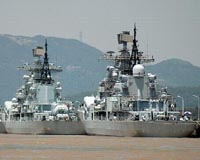| . |  |
. |
Washington DC (SPX) Sep 16, 2010 Scientists have for the first time estimated the physical footprint of human activities on the deep seafloor of the North East Atlantic. The findings published in the journal PLoS ONE reveal that the area disturbed by bottom trawling commercial fishing fleets exceeds the combined physical footprint of other major human activities considered. The deep seafloor covers approximately 60% of Earth's surface, but only a tiny fraction of it has been studied to date. Yet as technology advances and resources from relatively shallow marine environments are depleted, human impacts on the deep seafloor are likely to increase. "Information on the location and spatial extent of human activities affecting the deep-sea environment is crucial for conservation of seafloor ecosystems and for governance and sustainable management of the world's oceans," said Angela Benn of the National Oceanography Centre, who led the new study. The researchers focused on the OSPAR maritime area of the North East Atlantic, where human activities are particularly intense. The area covers over eleven million square kilometres, about 75 percent of which is deeper than 200 metres, and includes important fishing grounds such as those of Hatton and Rockall. Using available data for the year 2005, they mapped and estimated the spatial extent of intentional human activities occurring directly on the seafloor as well as structures and artefacts present on the seafloor resulting from past activities. They looked exclusively at the physical footprint rather than the consequential ecological effects of disturbance, contamination and pollution, which are harder to ascertain. One difficulty that they faced was that of accessing data on human activities that was accurate, up to date and comprehensive, and in a suitable format for analysis. "Some governments, public organisations and private companies were far more forthcoming with information than others," explained Benn. "Significant improvements are needed in data collection and availability, and this requirement needs to be built into international conventions and treaties with a legal framework in place to ensure informed environmental management." Despite difficulties and various uncertainties, the researchers' assessment suggests that, although now banned, previously dumped radioactive waste, munitions and chemical weapons together have the lowest physical footprint of the human activities considered, although they do not consider potential dispersal after leakage. Non-fisheries marine scientific research also has a relatively small footprint, whereas those of fisheries marine scientific research, telecommunication cables and the oil and gas industry are moderate. However, even on the lowest estimates, the spatial extent of bottom trawling is at least ten times that for the other activities assessed, with a physical footprint greater than that of all the others combined. The study estimated the total area of physical imprint in 2005 to be around 28,000 km2. However many human activities in the deep sea are concentrated in certain areas, particularly in shallower depths between 200 m and 1500 m, and in particular habitats which become disproportionally impacted. The OSPAR area comprises many different habitats each with different and diverse ecosystems. The percentage impact in each of these habitats would provide important information but unfortunately there is virtually no detailed seabed mapping to provide this information. As demands drive human activities ever deeper the imprint will become more widespread. "Consequently," argues Benn, "there needs to be a much greater understanding of the relative impacts of human activities on the deep seafloor, and in particular how these activities affect seafloor ecosystems and biodiversity."
Share This Article With Planet Earth
Related Links National Oceanography Centre Water News - Science, Technology and Politics
 China-Japan row boils despite release of fishing crew
China-Japan row boils despite release of fishing crewTokyo, Japan (AFP) Sept 13, 2010 Japan on Monday released the 14 crew of a Chinese fishing trawler seized last week but kept its captain in custody, doing little to soothe Beijing's fury in a bitter row between the Asian rivals. The diplomatic spat centres on a disputed island chain in the East China Sea, where Japan says the Chinese boat was fishing illegally last week and, when ordered to leave, rammed two Japanese coastg ... read more |
|
| The content herein, unless otherwise known to be public domain, are Copyright 1995-2010 - SpaceDaily. AFP and UPI Wire Stories are copyright Agence France-Presse and United Press International. ESA Portal Reports are copyright European Space Agency. All NASA sourced material is public domain. Additional copyrights may apply in whole or part to other bona fide parties. Advertising does not imply endorsement,agreement or approval of any opinions, statements or information provided by SpaceDaily on any Web page published or hosted by SpaceDaily. Privacy Statement |